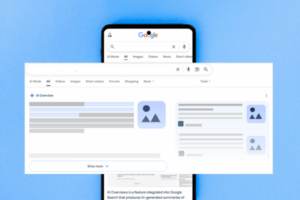
It’s time to surge past the uncertainty and wariness caused by the pandemic and charge ahead with confidence that you’re making the right moves to grow your business. That’s why we surveyed 170+ digital marketing professionals from brands and retailers in a wide range of industries and business types to determine the top trends, initiatives, and concerns for marketers this year. In this article, dive into the top 5 digital marketing initiatives that brands are focusing on in 2022.
1. Paid Search Advertising
Paid search advertising is the top initiative for digital marketing professionals this year, with 55% naming it as a priority for their brand in 2022. Paid search ads make up 41% of all digital ad spend, and by 2024, spending will approach $100 billion.
With all of the uncertainty that came at the beginning of the pandemic in early 2020, paid search ad spend declined significantly as brands and retailers reduced their budgets. Paid advertising spend on Google was up 14% year-over-year in February 2020, but in March 2020, growth dropped to just 4%. Ad spend stabilized again by March 2021 to 14% YoY growth.
Since then, digital search ad spending has increased significantly as brands try to reach the consumers who spend more time online. After growing just 5.9% from 2019 to 2020 to pass $58 billion, US search ad spending grew 46% in 2021 to reach $84.7 billion – and this year, it’s expected to grow 12.4% to reach a record $95.2 billion.
Google is by far the leading traditional search engine for paid advertising, with 86% of the desktop market share for search engines as of January 2022. Microsoft Bing comes in at 8%, followed by Yahoo! at 3%. Google dominates even more on mobile, with 93.3% of the mobile market share for search engines.
Mobile accounts for over two-thirds of total paid search ad clicks. As of 2020, US mobile paid search ad spend came in at $32.6 billion. By 2025, it’s expected to reach $51.7 billion. Desktop still reigns for Microsoft Bing, however. As of Q4 2021, just 26% of Bing search ad clicks come from mobile.
Some of the Google Ad types that provide value to brands and retailers include:
- Discovery Ads: Mobile-focused ads that leverage user intent data like search history, app downloads, location, and more to automatically target shoppers on Google’s Discover feed, Gmail, and YouTube.
- Shopping Ads: Product-centric, image-focused ads that appear at the top of organic search results pages personalized Google Shopping feeds, enabling shoppers to purchase products directly from Google.
- Display Ads: Visual ads that showcase your product to users who likely aren’t familiar with it, focusing on top-of-funnel brand awareness.
Paid search advertising has always been a competitive landscape. In 2021, it became even more competitive as costs per click (CPCs) skyrocketed for the second year in a row. Google Ads CPCs grew 15-25% in 2021 and are expected to rise 20-40% in 2022.
The growth in CPCs could explain why paid search is less of a focus this year for brands that make less than $10 million in annual revenue. Conversely, it’s the top initiative for brands with $100M-$1B in annual revenue.
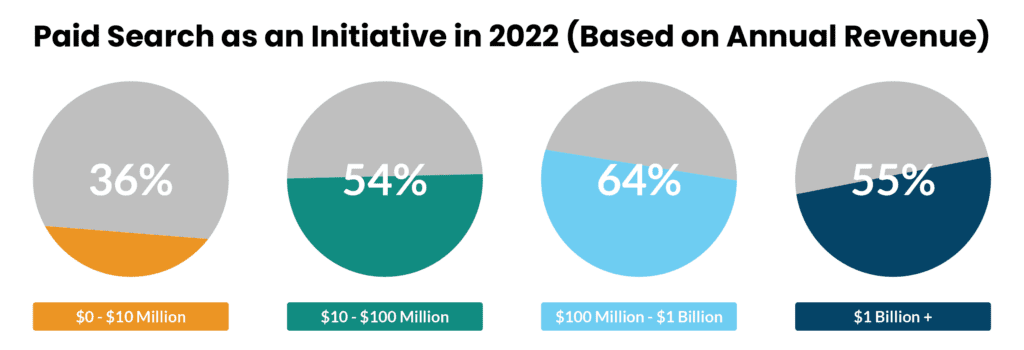
Automation, Smart Shopping, & Performance Max
28% of marketers use automation in their PPC advertising efforts. Since May 2018, a key component of paid search advertising has been Google Smart Shopping, which uses AI and automation to display ads to relevant customers across Google platforms to get the most out of your ad spend. But this year, brands advertising on Smart Shopping will be switched to Performance Max.
The process will begin in April 2022 and all campaigns will be switched over by September 2022. Brands that switch to Performance Max see an average 12% increase in conversion value at the same or higher ROAS. Performance Max offers new automation and inventory insights on top of a foundation of Smart Shopping and Local campaigns, including the ability to access all of Google’s ad inventory across channels from one campaign.
According to our research, 34% of marketing decision-makers feel that automation and AI are top trends for 2022. Using automation and AI as the foundation of your strategy will help save time and drive conversions to grow your brand’s revenue.

2. Search Engine Optimization
The second biggest priority for brands in 2022 is the organic side of things. 54% marketers name search engine optimization (SEO) as a top initiative for their brand this year. With the rise in CPCs across industries, optimizing your organic presence can be a key way to boost clicks without breaking your budget.
But SEO isn’t only for low-budget brands. Showing up before your competitors in a search is a huge priority for any brand that wants profitable growth. 55% of brands making over $1 billion in annual revenue say SEO is a top initiative for their brand this year, tying in second place with paid search as the most important initiative for these high-grossing businesses. SEO is the most important initiative for brands making $10-$100 million in annual revenue this year.
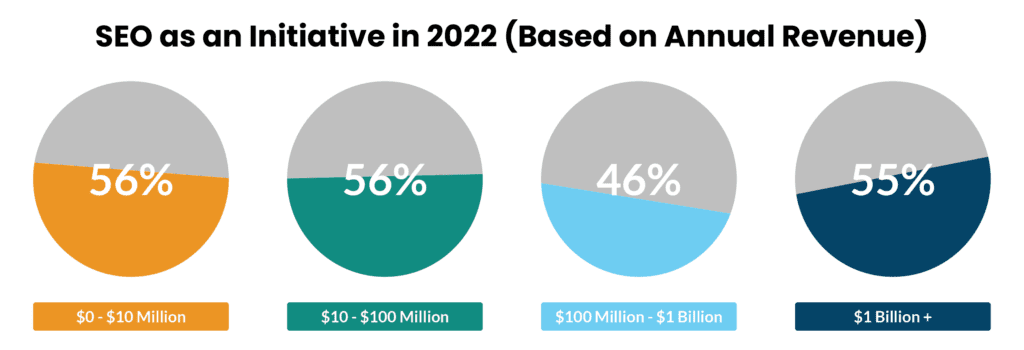
In January 2022, Google launched a Shops section in mobile organic search results that shows up to 10 retailers based on their organic rankings. Ecommerce is a growing part of Google’s strategy, and with this added emphasis on driving sales through organic search rankings, brands can’t afford to ignore search engine optimization this year. It’s no wonder that more than 50% of marketing decision-makers say both paid search and SEO are top initiatives for their brand this year.
Video | Organic traffic alone rarely rises to the levels of traffic achieved through paid plus organic efforts. Search engine optimization and paid search advertising is a 1 + 1 = 3 relationship. At ROI, we call SEO and paid search the digital search duopoly. This powerhouse duo gives your brand the ability to dominate the first page of search results and supercharge your presence on Google, Microsoft Bing, and YouTube. In this webinar replay, discover insights to drive more qualified traffic to your website by optimizing your paid and organic presence. Watch the video.
Search engines are the most common brand discovery channel, with 32% of internet users saying they find new brands or products this way. Ranking first on the first page of Google search results has a huge impact on your conversion rate. The first result on a Google SERP has a click-through rate (CTR) of 31.7%.
As of Q4 2021, mobile makes up 63% of all US search engine visits. Comparatively, mobile organic search engine visits made up just 56% of all visits in Q1 2020. Mobile’s share of organic search engine visits has been steadily increasing since 2013, when it made up just 27% of search visits. The pandemic pushed people online more, and the growth of mobile traffic is a key part of that.
The coronavirus pandemic also contributed to challenges in the search engine optimization world in 2021. 27.9% of SEO professionals say pandemic-related issues were a challenge for them as of June 2021. The top obstacle for SEO in 2021 was budget cuts, with 37.6% of SEO professionals naming it as a challenge, followed by strategy issues at 34.8% and a lack of resources at 32.9%. 27% name alignment with other departments as an issue.
Google frequently releases algorithm updates that impact how web pages rank on search engine results pages (SERPs). In 2021, those updates were more extreme than usual. Search engine rank volatility was 84% higher on mobile and 68% higher on desktop year-over-year.
50% of the days in 2021 had high levels of rank volatility on mobile compared to 27.2% in 2020. On desktop, 44.6% of the days in 2021 were highly volatile compared to 26.5% in 2020.
Google doesn’t release much about exactly how they rank content, but SEO professionals say that the most important factors for SEO search rankings are on-page elements (e.g. meta descriptions), organic user behavior, and depth and accuracy of content. The top activity for SEO professionals is keyword research, with 36.3% saying they spend most of their time on it, followed by on-page factors (33.4%), analytics (30.9%), and technical SEO (25.7%).

3. Conversion Rate Optimization
Your PPC and SEO efforts lead shoppers to your website – but if your site isn’t optimized for conversions, even the biggest boost in traffic won’t touch your bottom line.
The valuable time that you spend creating ads means nothing if customers don’t click them, and those clicks mean nothing if the customer doesn’t convert once they get to your site. Optimizing your ads and your website to increase conversions and get more sales is everything.
52% of digital marketing professionals say conversion rate optimization is a big initiative for their brand in 2022.
It’s no wonder that conversion rate optimization is tied with paid search as the top priority among digital marketing decision-makers for 2022. It’s also the top initiative for home goods brands this year.
Tracking the right key performance indicators (KPIs) is crucial in digital marketing. Being able to prove that the budget your business is putting toward generating more revenue is actually contributing to generating more revenue is easier said than done. For data-driven marketers, conversion rate is the top metric to track.
You can optimize your brand’s presence for conversions across your entire digital marketing strategy, including:
- Your website’s checkout experience (e.g. button text, colors, and copy)
- Landing page copy on your website (e.g. complimentary vs. fear-based language)
- Ad copy on Amazon, paid search, social media, or anywhere else you advertise
- Content and images in promotional emails and newsletters that you send to your customer database
While mobile reigns in terms of traffic and impressions, when it comes to conversion rates, desktop is king. As of Q3 2021, the average conversion rate of online shoppers on desktop is 3.7% compared to just 2.2% for mobile. Tablets have a conversion rate of 3.3%.
Conversion rate optimization varies in importance to a business depending on its annual revenue. As a company generates more sales and drives more conversions, conversion rate optimization steadily becomes a lower priority. It’s a top initiative for more than 50% of brands with under $1 billion in annual revenue compared to just 31.9% of brands making over $1 billion.
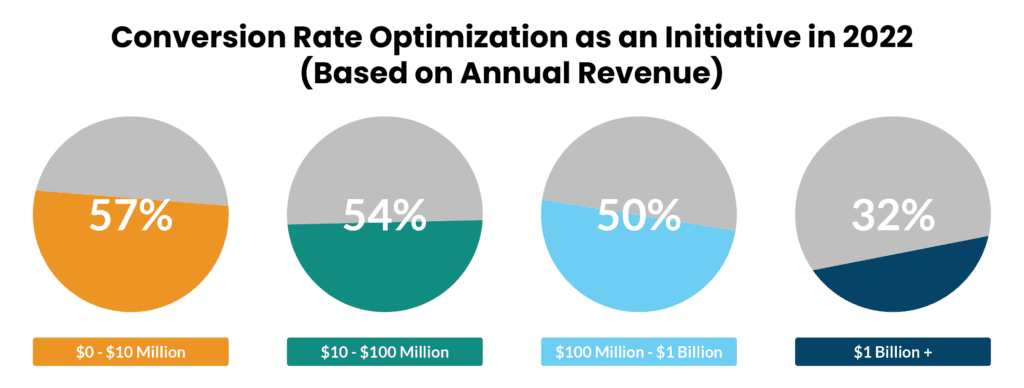
A/B Testing
A/B testing (also known as split testing) is a key component of a conversion rate optimization strategy. With A/B testing, brands can run a randomized experiment to show two different versions of a campaign to their target audience and determine which resonates the most. Some common factors that are used in A/B tests are landing page copy, email subject line, or button color.
A/B tests are a key way to determine how you can drive more conversions from your website, emails, and other marketing efforts. Companies that split test all of their marketing emails see 37% higher returns than companies that don’t. In fact, growing your email CTR by just 0.5% can result in as much as 25% revenue growth. The most commonly tested items in emails are subject lines, images, and content.
The key to A/B testing is understanding that you’ll likely get unexpected results. That’s why it’s so important to do. Making assumptions about what you think will perform best – or worse, what resonates with you as opposed to your target audience – is a recipe for disaster.
If you’re running A/B tests on your campaigns, you have the opportunity to build your company’s culture of experimentation. You can be the champion who helps your company embrace testing and make major gains both short-term and long-term.
Case Study | On average, only 12-15% of A/B tests have a winning result. At ROI, we have an A/B test win rate of 42%! We helped one home goods brand increase their conversion rates by 34% after performing successful A/B tests on their mobile site. Read the case study to learn more.

4. Social Media
50% of digital marketing professionals say that social media is a big initiative for their brand in 2022. Social media has a wide variety of valuable purposes for consumers, making it a key channel for brand discovery and awareness marketing. 77% of internet users use social media to search for more information on brands. 27.8% use it to see what’s trending and 26.8% use it to find inspiration.
Q2 2020 was the highest time period on record globally for social media usage. Growth has leveled out now, but usage remains much higher than expected pre-pandemic. North American internet users spent 2 hours and 11 minutes per day on social media in Q3 2021 compared to 2 hours and 2 minutes in Q3 2019. Gen Z users spend the most time on social media at around three hours per day.
26% of social media users say Facebook is their favorite service, and it’s the most popular social media platform for Baby Boomers. Facebook is the most popular social network worldwide by user count, coming in at 2.1 billion active monthly users compared to Instagram at 1.3 billion and TikTok at 755 million.
As the pandemic wanes, social media usage may decline. 9% of users are more likely to spend less time on social media this year than in 2020. More than 1 in every 4 consumers worry they spend too much time on social media, including 37% of Gen Z.
Nearly 1 in every 3 of our survey respondents name authenticity as a top trend for 2022. As authenticity becomes more important, consumers are changing the way they use social media. 30.3% of social media users say they care less about impressing others on social media than they used to, and 24.5% say they’re more open online about how they’re feeling. Brands can reach more consumers (especially Gen Z and Millennials) by developing a social media presence that both showcases authenticity and encourages customers to be authentic themselves.
Social Commerce
Social commerce refers to the ability to purchase items directly through platforms like Instagram, Facebook, Snapchat, and TikTok. US social commerce buyers are expected to grow 6.1% this year to reach 96.1 million shoppers. That number will climb to 101.1 million in 2023.
The popularity of social commerce has been rising steadily since 2017, when there were just 45.8 million social commerce buyers. 2020 was the biggest year of growth yet, with more than a 25% increase in social commerce users as the pandemic pushed shoppers toward ecommerce.
Social commerce will grow 3x faster than traditional ecommerce between now and 2025.
Social commerce can make it easier for brands to track conversions because the entire path to purchase happens on one platform. Many brands are turning to social commerce as a solution to alleviate cookie-based attribution confusion by engaging and converting consumers on a single channel and device.
Influencer Marketing
Influencer marketing is a top initiative for 35% of the brands we surveyed, making it a higher priority than Amazon, lead generation, or design and creative.
15% of internet users discover brands via celebrities or other well-known individuals on social media. The ability to follow celebrities or influencers is now a key reason to use social media for nearly 1 in every 5 internet users.
Out of all the industries we surveyed, influencer marketing is the biggest priority for home goods brands. The home goods industry will be worth $188.1 billion in 2022, a nearly $20 billion increase over 2019. With the market expected to reach $202 billion by 2024, home goods brands should consider exploring unique and creative strategies like influencer marketing to stand out from all the competition.
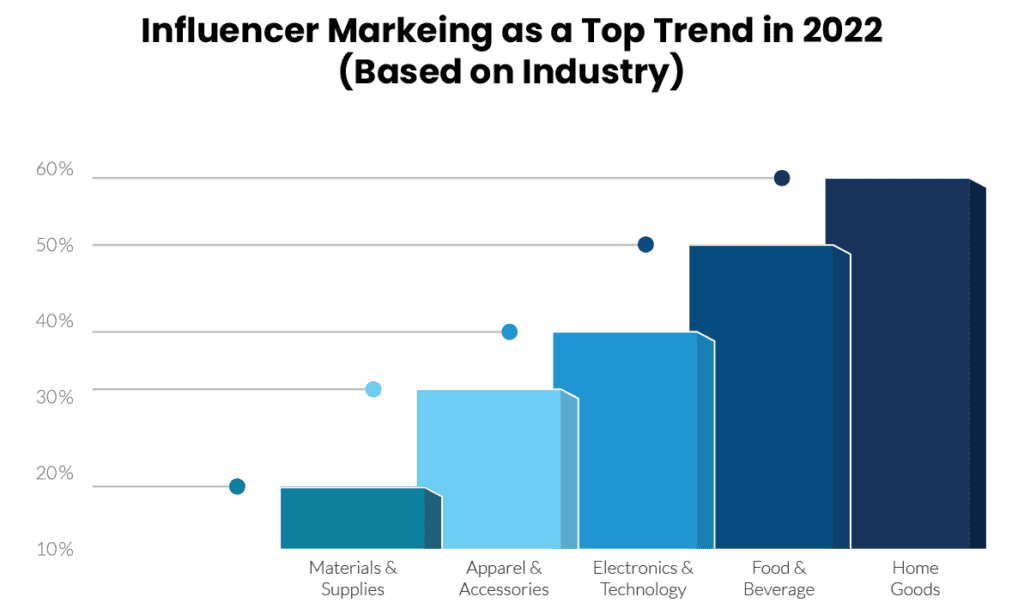
Augmented & Virtual Reality
Out of the digital marketers who say augmented reality (AR) and virtual reality (VR) are top-of-mind for their brand in 2022, 58% also say social media is a major initiative. AR and VR will have 165.6 million monthly users in 2022 compared to just 115.9 million in 2019.
36.7% of social media users say they pay more attention to advertising that incorporates augmented reality. From the Metaverse to new online shopping capabilities to video games, AR and VR are beginning to take shape in the digital marketing landscape.
49.3% of social media users say AR makes the shopping experience easier, with that number highest for TikTok at 56%. 43% of Instagram users say AR makes the shopping experience easier. Around 1 in every 3 social media users say augmented reality is helpful for trying on products they otherwise wouldn’t during the pandemic.
In January 2022, Pinterest introduced its Try On for Home Decor tool, which uses its AR-powered Pinterest Lens technology to give users the ability to upload a photo of a room and stage how furniture will look in it. The Pinterest Lens camera also enables users to try on beauty products. Pinterest users are 5x more likely to purchase a pinned product with the Try-On feature than other pins.
iOS 14.5 Impacts
Apple released iOS 14.5 in April 2021, transforming how brands advertise through social media. With the update, apps are required to display an App Tracking Transparency (ATT) prompt requesting the user’s permission to use their Identifier for Advertisers (IDFA).
The IDFA is a random identifier assigned to each iOS user that allows advertisers to deliver personalized ads in addition to providing tracking and attribution capabilities. Similar to a third-party cookie, each unique IDFA is attached to a user’s mobile device and gives advertisers valuable data to track the customer journey, provide relevant ads, and measure campaign performance.
Before the update, a user’s IDFA was automatically shared, and approximately 70% of iPhone users shared their IDFA with apps. Now, iPhone users are required to opt in if they want to share their IDFA. As of December 2021, 37% of iPhone users are opted in to the ATT prompt.

5. Content Marketing
Between SEO, content marketing, email marketing, and conversion rate optimization, one thing remains clear: Content is still king.
Content marketing costs 62% less than traditional marketing methods, yet it generates 3x more leads. Content is an appealing option to marketers not just to generate awareness with your target audience but also to drive traffic to your site at a low cost.
Email is the top preferred content type among all of our respondents. 81% of marketing professionals say they stay up-to-date on industry information via email and e-newsletters, with blogs and social media a distant second at 56% each.
When it comes to sharing and developing content, knowing your audience is crucial. 81% of marketing managers stay up-to-date via blog posts compared to just 42% of decision-makers. On top of that, only 8% of decision-makers stay up-to-date via video and streaming compared to 37% of doers.
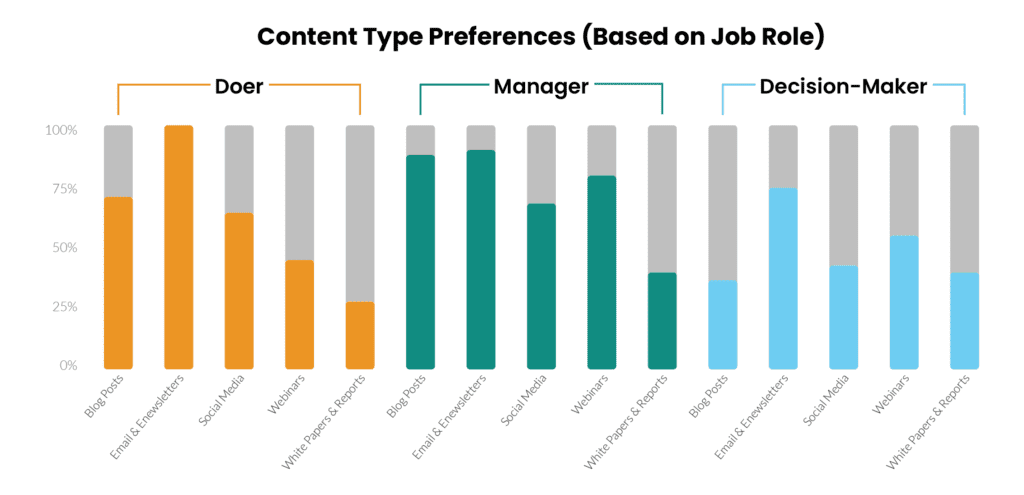
Email Marketing
Email is by far the top content type preferred by our respondents, with more than 4 in 5 professional marketers saying they stay up-to-date on industry trends and news through email and enewsletters.
Email marketing is one of the most profitable channels for marketers, enabling brands to reach the more than 4 billion consumers around the globe who use email. After generating $8.5 billion in revenue last year, email marketing is expected to reach $9.62 billion this year and grow to $10.9 billion in 2023.
By 2027, email marketing is expected to generate $17.9 billion in revenue globally – more than double what it was in 2020.
But with email such an appealing initiative for many brands, competition will be fierce. In fact, more than 333 billion emails will be sent and received each day in 2022. By 2025, that number will reach 376.4 billion. It will be more critical than ever this year for brands to stand out with emails that are visually appealing, are personalized and tailored to the reader, and function exactly as intended.
Blog Posts
Businesses that have a blog drive twice as much email traffic and get 97% more links to their website than companies that don’t. Blogs are also a key way to generate more website visits, making them a great driver of brand awareness.
Blog traffic is largely driven by organic searches and email marketing. Blog visitors from organic initiatives are much more likely to convert than traffic from outbound efforts like email marketing. Leads that come to a blog organically have a 14.6% close rate, compared to 1.7% for outbound leads.
Do keep in mind, though, that for the marketing budget you’re saving with organic content initiatives, a valuable blog strategy requires your team to spend time intentionally strategizing, writing, and optimizing content. Articles that are 2,000 words or longer are much more likely to have strong results, and the average blog post takes 3.5 hours to write. On top of that, articles of 3,000+ words get twice the amount of page views and 24% more shares.
White Papers & Reports
White papers are much more likely to resonate with managers and decision-makers than doers. 26% of marketing doers say they stay up-to-date via white papers and reports, compared to around 43% of managers and decision-makers. Conversely, social media is much more likely to resonate with doers, with 67% saying they stay up-to-date via social media compared to 45% of decision-makers.
The magic of content is that it can be reshaped and repurposed across different formats and channels. Content that a writer spends a lot of time creating can have exponential value if it’s spread across multiple formats and reorganized in efficient ways to cater to different audiences, then promoted across various channels.
For example, a long white paper can be split into multiple blog posts that contain less information to entice users to download the full report. That content can also be used to write scripts for webinars, podcasts, or videos. You can then share this content in your email and social media marketing in a personalized way.
Sources:
- eMarketer. “Search Marketing 2020” https://www.emarketer.com/content/search-marketing-2020
- Statista. “Change in paid search advertising spending on Google in the United States from January 2020 to September 2021” https://www.statista.com/statistics/258224/paid-search-ad-spending-usa/
- Statista. “Advertising revenue of Google from 2001 to 2021” https://www.statista.com/statistics/266249/advertising-revenue-of-google/
- Statista. “Worldwide desktop market share of leading search engines from January 2010 to July 2022” https://www.statista.com/statistics/216573/worldwide-market-share-of-search-engines/
- Statista. “Market share of selected leading mobile search providers in the United States from October 2012 to January 2022” https://www.statista.com/statistics/511358/market-share-mobile-search-usa/
- Statista. “Paid search click share of phone and tablet devices in the United States as of 1st quarter 2021” https://www.statista.com/statistics/250951/us-mobile-device-share-paid-search-clicks/
- Statista. “Mobile advertising spending in the United States from 2017 to 2026, by format” https://www.statista.com/forecasts/258488/mobile-marketing-sales-impact-in-the-us-by-type
- Statista. “Paid Mobile Search Click Share of Google and Microsoft Advertising in the United States as of 1st quarter 2021, by Device” https://www.statista.com/statistics/223308/trend-in-impressions-on-google-and-bing-in-the-us/
- WordStream. “Google Ads Benchmarks for YOUR Industry [Updated!]” https://www.wordstream.com/blog/ws/2016/02/29/google-adwords-industry-benchmarks
- Statista. “Marketing channels using automation worldwide as of June 2021” https://www.statista.com/statistics/1269813/marketing-channels-automation/
- Google. “Get ready for Smart Shopping and Local campaign upgrades” https://blog.google/products/ads-commerce/upgrade-to-performance-max/
- mediawire. “Google Introduces a New ‘Shops’ Sections in Mobile Search Results” https://www.mediawire.in/blog/seo/google-introduces-a-new-shops-sections-in-mobile-search-results-80544114.html
- ROI Revolution. “The Digital Search Duopoly” https://roirevolution.com/resorces/videos/digital-search-duopoly/
- Backlinko. “Here’s What We Learned About Organic Click Through Rate” https://backlinko.com/google-ctr-stats
- Statista. “Mobile share of organic search engine visits in the United States from 3rd quarter 2013 to 4th quarter 2021” https://www.statista.com/statistics/297137/mobile-share-of-us-organic-search-engine-visits/
- Statista. “Leading search engine optimization (SEO) challenges worldwide as of June 2021” https://www.statista.com/statistics/1274478/seo-challenges/
- Search Engine Roundtable. “Semrush: Google Search Algorithm Updates Are More Extreme This Year” https://www.seroundtable.com/google-search-algorithm-updates-more-extreme-32277.html
- Statista. “Leading search engine optimization (SEO) factors for search rankings worldwide as of June 2021” https://www.statista.com/statistics/633151/effective-seo-tactics/
- Search Engine Land. “State of SEO Report” https://www.searchenginejournal.com/state-of-seo/
- Statista. “Conversion rate of online shoppers in the United States from 4th quarter 2020 to 4th quarter 2021, by device” https://www.statista.com/statistics/234884/us-online-shopper-conversion-rate-by-device/
- Litmus. “The ROI of Email Marketing [Infographic]” https://www.litmus.com/blog/infographic-the-roi-of-email-marketing
- ROI Revolution. “Case Study: Home Goods Brand” https://roirevolution.com/learn/case-studies/cro-homegoods/
- GWI. “The biggest social media trends for 2022” https://www.gwi.com/reports/social
- eMarketer. “Social Commerce 2021” https://www.emarketer.com/content/social-commerce-2021
- Newsroom. “Pinterest introduces AR Try On for Home Décor for the ultimate online home shopping experience” https://newsroom.pinterest.com/en/post/pinterest-introduces-ar-try-on-for-home-decor-for-the-ultimate-online-home-shopping-experience
- The Motley Fool. “Apple’s Latest Privacy Move Is a Blow for Facebook, but Not The Trade Desk. Here’s Why.” https://www.fool.com/investing/2021/01/04/apple-privacy-drops-bomb-facebook-trade-desk/
- eMarketer. “The Shakeout from Apple’s Privacy Update” https://www.emarketer.com/content/shakeout-apple-privacy-update
- Highervisibility. “42 CONVERSION RATE OPTIMIZATION STATISTICS THAT YOU NEED TO KNOW IN 2021” https://www.highervisibility.com/blog/conversion-rate-optimization-statistics/
- Statista. “Number of e-mail users worldwide from 2017 to 2025” https://www.statista.com/statistics/255080/number-of-e-mail-users-worldwide/
- Statista. “E-mail marketing revenue worldwide from 2020 to 2027” https://www.statista.com/statistics/812060/email-marketing-revenue-worldwide/
- Statista “Number of sent and received e-mails per day worldwide from 2017 to 2025” https://www.statista.com/statistics/456500/daily-number-of-e-mails-worldwide/
- Optinmonster. “Ultimate List of Blogging Statistics and Facts (Updated for 2022)” https://optinmonster.com/blogging-statistics/




